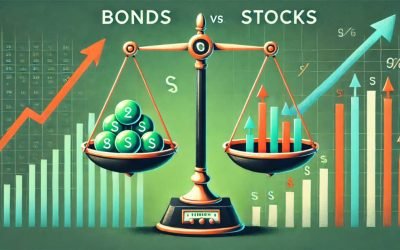Understanding Financial Metrics: A Comprehensive Guide
In the world of finance, understanding the key financial metrics for analysing companies is crucial for investors, analysts, and business owners alike. These metrics provide valuable insights into a company’s financial health, operational efficiency, and overall performance. This article delves into the most important financial metrics, explaining their significance and how they can be used to make informed decisions.
1. Revenue and Sales Growth
Revenue, also known as sales or turnover, is the total amount of money generated by a company’s operations. It is a fundamental metric that indicates the scale of a company’s business activities. Sales growth, on the other hand, measures the rate at which a company’s revenue is increasing or decreasing over a specific period.
- Importance: Revenue and sales growth are critical indicators of a company’s market demand and business expansion.
- Calculation: Sales Growth = [(Current Period Revenue – Previous Period Revenue) / Previous Period Revenue] * 100
2. Gross Profit Margin
Gross profit margin is a profitability ratio that shows the percentage of revenue that exceeds the cost of goods sold (COGS). It reflects a company’s ability to produce goods or services at a profit.
- Importance: A higher gross profit margin indicates better efficiency in production and cost management.
- Calculation: Gross Profit Margin = [(Revenue – COGS) / Revenue] * 100
3. Operating Profit Margin
Operating profit margin, also known as operating margin, measures the percentage of revenue left after covering operating expenses, excluding interest and taxes. It provides insights into a company’s operational efficiency.
- Importance: A higher operating margin suggests that a company is effectively managing its operating costs.
- Calculation: Operating Profit Margin = (Operating Income / Revenue) * 100
4. Net Profit Margin
Net profit margin is the percentage of revenue that remains as profit after all expenses, including taxes and interest, have been deducted. It is a key indicator of a company’s overall profitability.
- Importance: A higher net profit margin indicates better overall financial health and profitability.
- Calculation: Net Profit Margin = (Net Income / Revenue) * 100
5. Earnings Per Share (EPS)
Earnings per share (EPS) is a financial metric that indicates the portion of a company’s profit allocated to each outstanding share of common stock. It is a widely used indicator of a company’s profitability on a per-share basis.
- Importance: EPS is crucial for investors as it helps them assess the company’s profitability and make investment decisions.
- Calculation: EPS = (Net Income – Dividends on Preferred Stock) / Average Outstanding Shares
6. Price-to-Earnings (P/E) Ratio
The price-to-earnings (P/E) ratio is a valuation metric that compares a company’s current share price to its earnings per share. It helps investors determine the market value of a stock relative to its earnings.
- Importance: A high P/E ratio may indicate that a stock is overvalued, while a low P/E ratio may suggest it is undervalued.
- Calculation: P/E Ratio = Share Price / Earnings Per Share
7. Return on Equity (ROE)
Return on equity (ROE) measures a company’s profitability by revealing how much profit it generates with the money shareholders have invested. It is a key indicator of financial performance and efficiency.
- Importance: A higher ROE indicates that a company is effectively using shareholders’ equity to generate profits.
- Calculation: ROE = (Net Income / Shareholders’ Equity) * 100
8. Return on Assets (ROA)
Return on assets (ROA) measures a company’s ability to generate profit from its assets. It indicates how efficiently a company is using its assets to produce earnings.
- Importance: A higher ROA suggests better asset utilisation and operational efficiency.
- Calculation: ROA = (Net Income / Total Assets) * 100
9. Debt-to-Equity Ratio
The debt-to-equity ratio is a leverage ratio that compares a company’s total debt to its shareholders’ equity. It provides insights into a company’s financial structure and risk level.
- Importance: A higher debt-to-equity ratio indicates higher financial risk, while a lower ratio suggests a more stable financial position.
- Calculation: Debt-to-Equity Ratio = Total Debt / Shareholders’ Equity
10. Current Ratio
The current ratio is a liquidity ratio that measures a company’s ability to pay off its short-term liabilities with its short-term assets. It is an important indicator of financial health and liquidity.
- Importance: A higher current ratio indicates better liquidity and financial stability.
- Calculation: Current Ratio = Current Assets / Current Liabilities
11. Quick Ratio
The quick ratio, also known as the acid-test ratio, is a liquidity ratio that measures a company’s ability to meet its short-term obligations with its most liquid assets. It excludes inventory from current assets.
- Importance: A higher quick ratio indicates better short-term financial health and liquidity.
- Calculation: Quick Ratio = (Current Assets – Inventory) / Current Liabilities
12. Cash Flow from Operations (CFO)
Cash flow from operations (CFO) is a measure of the cash generated by a company’s core business activities. It provides insights into a company’s ability to generate cash to fund its operations and growth.
- Importance: Positive CFO indicates strong operational performance and financial health.
- Calculation: CFO is typically found in the cash flow statement and is calculated by adjusting net income for changes in working capital and non-cash expenses.
13. Free Cash Flow (FCF)
Free cash flow (FCF) is the cash generated by a company after accounting for capital expenditures. It represents the cash available for distribution to shareholders, debt repayment, or reinvestment in the business.
- Importance: Positive FCF indicates a company’s ability to generate surplus cash, which can be used for growth or returning value to shareholders.
- Calculation: FCF = Cash Flow from Operations – Capital Expenditures
14. Dividend Yield
Dividend yield is a financial ratio that shows the annual dividend payment as a percentage of the stock’s current price. It indicates the return on investment from dividends alone.
- Importance: A higher dividend yield can be attractive to income-focused investors.
- Calculation: Dividend Yield = (Annual Dividends per Share / Share Price) * 100
15. Payout Ratio
The payout ratio is the percentage of earnings paid out as dividends to shareholders. It provides insights into a company’s dividend policy and sustainability.
- Importance: A lower payout ratio suggests that a company is retaining more earnings for growth, while a higher ratio indicates a focus on returning value to shareholders.
- Calculation: Payout Ratio = (Dividends per Share / Earnings per Share) * 100
16. Interest Coverage Ratio
The interest coverage ratio measures a company’s ability to pay interest on its outstanding debt. It is an important indicator of financial stability and risk.
- Importance: A higher interest coverage ratio indicates better financial health and lower risk of default.
- Calculation: Interest Coverage Ratio = Operating Income / Interest Expense
17. Asset Turnover Ratio
The asset turnover ratio measures a company’s efficiency in using its assets to generate revenue. It indicates how well a company is utilising its assets to produce sales.
- Importance: A higher asset turnover ratio suggests better asset utilisation and operational efficiency.
- Calculation: Asset Turnover Ratio = Revenue / Total Assets
18. Inventory Turnover Ratio
The inventory turnover ratio measures how quickly a company sells its inventory within a specific period. It is an important indicator of inventory management and operational efficiency.
- Importance: A higher inventory turnover ratio indicates efficient inventory management and strong sales performance.
- Calculation: Inventory Turnover Ratio = Cost of Goods Sold / Average Inventory
19. Days Sales Outstanding (DSO)
Days sales outstanding (DSO) measures the average number of days it takes for a company to collect payment from its customers after a sale. It is an important indicator of cash flow and credit management.
- Importance: A lower DSO indicates efficient credit management and quicker cash collection.
- Calculation: DSO = (Accounts Receivable / Total Credit Sales) * Number of Days
20. Days Inventory Outstanding (DIO)
Days inventory outstanding (DIO) measures the average number of days it takes for a company to sell its inventory. It is an important indicator of inventory management and operational efficiency.
- Importance: A lower DIO indicates efficient inventory management and quicker inventory turnover.
- Calculation: DIO = (Average Inventory / Cost of Goods Sold) * Number of Days
21. Days Payable Outstanding (DPO)
Days payable outstanding (DPO) measures the average number of days it takes for a company to pay its suppliers after receiving goods or services. It is an important indicator of cash flow management and supplier relationships.
- Importance: A higher DPO indicates better cash flow management and longer payment terms with suppliers.
- Calculation: DPO = (Accounts Payable / Cost of Goods Sold) * Number of Days
22. Cash Conversion Cycle (CCC)
The cash conversion cycle (CCC) measures the time it takes for a company to convert its investments in inventory and other resources into cash flows from sales. It is an important indicator of operational efficiency and cash flow management.
- Importance: A shorter CCC indicates better operational efficiency and quicker cash flow generation.
- Calculation: CCC = DIO + DSO – DPO
23. Market Capitalisation
Market capitalisation, or market cap, is the total market value of a company’s outstanding shares of stock. It is an important indicator of a company’s size and market value.
- Importance: Market cap helps investors assess the relative size and value of a company compared to others in the market.
- Calculation: Market Capitalisation = Share Price * Total Outstanding Shares
24. Enterprise Value (EV)
Enterprise value (EV) is a measure of a company’s total value, including its market capitalisation, debt, and cash. It provides a comprehensive view of a company’s valuation.
- Importance: EV is used in various valuation metrics, such as EV/EBITDA, to assess a company’s overall value and performance.
- Calculation: EV = Market Capitalisation + Total Debt – Cash and Cash Equivalents
25. EV/EBITDA Ratio
The EV/EBITDA ratio is a valuation metric that compares a company’s enterprise value to its earnings before interest, taxes, depreciation, and amortisation (EBITDA). It is used to assess a company’s overall value and performance.
- Importance: A lower EV/EBITDA ratio may indicate that a company is undervalued, while a higher ratio may suggest it is overvalued.
- Calculation: EV/EBITDA Ratio = Enterprise Value / EBITDA
26. Price-to-Book (P/B) Ratio
The price-to-book (P/B) ratio is a valuation metric that compares a company’s market value to its book value. It helps investors assess whether a stock is overvalued or undervalued.
- Importance: A lower P/B ratio may indicate that a stock is undervalued, while a higher ratio may suggest it is overvalued.
- Calculation: P/B Ratio = Market Value per Share / Book Value per Share
27. Dividend Payout Ratio
The dividend payout ratio is the percentage of earnings paid out as dividends to shareholders. It provides insights into a company’s dividend policy and sustainability.
- Importance: A lower payout ratio suggests that a company is retaining more earnings for growth, while a higher ratio indicates a focus on returning value to shareholders.
- Calculation: Dividend Payout Ratio = (Dividends per Share / Earnings per Share) * 100
28. Dividend Coverage Ratio
The dividend coverage ratio measures a company’s ability to pay dividends from its earnings. It is an important indicator of dividend sustainability and financial health.
- Importance: A higher dividend coverage ratio indicates better financial health and dividend sustainability.
- Calculation: Dividend Coverage Ratio = Earnings per Share / Dividends per Share
29. PEG Ratio
The PEG ratio is a valuation metric that compares a company’s price-to-earnings (P/E) ratio to its earnings growth rate. It helps investors assess whether a stock is overvalued or undervalued based on its growth potential.
- Importance: A lower PEG ratio may indicate that a stock is undervalued, while a higher ratio may suggest it is overvalued.
- Calculation: PEG Ratio = P/E Ratio / Earnings Growth Rate
30. Return on Invested Capital (ROIC)
Return on invested capital (ROIC) measures a company’s ability to generate returns from its invested capital. It is an important indicator of financial performance and efficiency.
- Importance: A higher ROIC indicates better financial performance and efficient use of capital.
- Calculation: ROIC = (Net Operating Profit After Tax / Invested Capital) * 100
31. Economic Value Added (EVA)
Economic value added (EVA) is a measure of a company’s financial performance that shows the value created beyond the required return on capital. It is an important indicator of value creation and financial performance.
- Importance: Positive EVA indicates that a company is generating value above its cost of capital, while negative EVA suggests value destruction.
- Calculation: EVA = Net Operating Profit After Tax – (Capital * Cost of Capital)
32. Total Shareholder Return (TSR)
Total shareholder return (TSR) measures the total return to shareholders, including capital gains and dividends. It is an important indicator of shareholder value and investment performance.
- Importance: A higher TSR indicates better investment performance and shareholder value creation.
- Calculation: TSR = [(Ending Stock Price – Beginning Stock Price) + Dividends] / Beginning Stock Price
33. Capital Expenditure (CapEx)
Capital expenditure (CapEx) is the amount of money a company spends on acquiring or maintaining fixed assets, such as property, plant, and equipment. It is an important indicator of investment and growth potential.
- Importance: Higher CapEx indicates a company’s focus on growth and expansion, while lower CapEx suggests

More reading:















 How to trade CFD? (00:49)
How to trade CFD? (00:49) How to trade binary options*? (01:22)
How to trade binary options*? (01:22) Forex. How to start? (01:01)
Forex. How to start? (01:01)